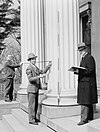File:CENTRAL SECTION, LOOKING FROM EAST IN SECTION U; VIEW INCLUDES HARRIET W. FRISHMUTH'S BERWIND MONUMENT AND SEVERAL MAUSOLEUMS - Laurel Hill Cemetery, 3822 Ridge Avenue, HABS PA,51-PHILA,100-46.tif

Original file (3,577 × 5,000 pixels, file size: 17.06 MB, MIME type: image/tiff)
Captions
Captions
Summary
[edit]| CENTRAL SECTION, LOOKING FROM EAST IN SECTION U; VIEW INCLUDES HARRIET W. FRISHMUTH'S BERWIND MONUMENT AND SEVERAL MAUSOLEUMS - Laurel Hill Cemetery, 3822 Ridge Avenue, Philadelphia, Philadelphia County, PA | |||||
|---|---|---|---|---|---|
| Photographer |
Boucher, Jack E. Related names:
|
||||
| Title |
CENTRAL SECTION, LOOKING FROM EAST IN SECTION U; VIEW INCLUDES HARRIET W. FRISHMUTH'S BERWIND MONUMENT AND SEVERAL MAUSOLEUMS - Laurel Hill Cemetery, 3822 Ridge Avenue, Philadelphia, Philadelphia County, PA |
||||
| Depicted place | Pennsylvania; Philadelphia County; Philadelphia | ||||
| Date |
1989 date QS:P571,+1989-00-00T00:00:00Z/9 |
||||
| Dimensions |
height: 7 in (17.7 cm); width: 5 in (12.7 cm) dimensions QS:P2048,7U218593 dimensions QS:P2049,5U218593 |
||||
| Current location |
Library of Congress Prints and Photographs Division Washington, D.C. 20540 USA http://hdl.loc.gov/loc.pnp/pp.print |
||||
| Accession number |
HABS PA,51-PHILA,100-46 |
||||
| Credit line |
|
||||
| Notes |
Yet the cemetery's significance extends well beyond an association with these individuals. In an era when cities suffered from crowding, disease, and scarcity of public space, Laurel Hill offered an "alternative environment." Amid clerical criticism and economic instability, the institution lured startling numbers of patrons and visitors. They came to experience artfully controlled nature; to see romantic monuments and to build them; to mix piety and patriotism, education and entertainment. Cemetery literature promised all of these things. Nonetheless, the institution ultimately placed property rights above public access. As Laurel Hill's visitation statistics fueled the Victorian crusade for urban parks, lot-holders built higher fences and managers wrote more restrictive rules. Today Laurel Hill stands as a landmark in the history of American architecture, landscape, and marketing. Spawned by a New Jersey Quaker's interest in horticulture, commemoration, and elite enterprise, it is an essay in Victorian taste and mores.
|
||||
| References |
|
||||
| Source | https://www.loc.gov/pictures/item/pa0961.photos.355472p | ||||
| Permission (Reusing this file) |
|
||||
| Object location | 39° 57′ 07.99″ N, 75° 09′ 51.01″ W | View this and other nearby images on: OpenStreetMap |
|---|
File history
Click on a date/time to view the file as it appeared at that time.
| Date/Time | Thumbnail | Dimensions | User | Comment | |
|---|---|---|---|---|---|
| current | 07:33, 3 August 2014 |  | 3,577 × 5,000 (17.06 MB) | Fæ (talk | contribs) | GWToolset: Creating mediafile for Fæ. HABS 2014-08-01 2601-2900 missing |
You cannot overwrite this file.
File usage on Commons
The following page uses this file:
Metadata
This file contains additional information such as Exif metadata which may have been added by the digital camera, scanner, or software program used to create or digitize it. If the file has been modified from its original state, some details such as the timestamp may not fully reflect those of the original file. The timestamp is only as accurate as the clock in the camera, and it may be completely wrong.
| Author | Library of Congress |
|---|---|
| Width | 3,577 px |
| Height | 5,000 px |
| Compression scheme | Uncompressed |
| Pixel composition | Black and white (Black is 0) |
| Orientation | Normal |
| Number of components | 1 |
| Number of rows per strip | 18 |
| Horizontal resolution | 700 dpi |
| Vertical resolution | 700 dpi |
| Data arrangement | chunky format |
| File change date and time | 11:09, 14 August 2002 |

